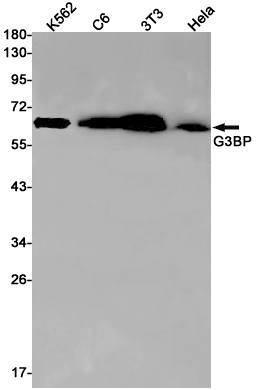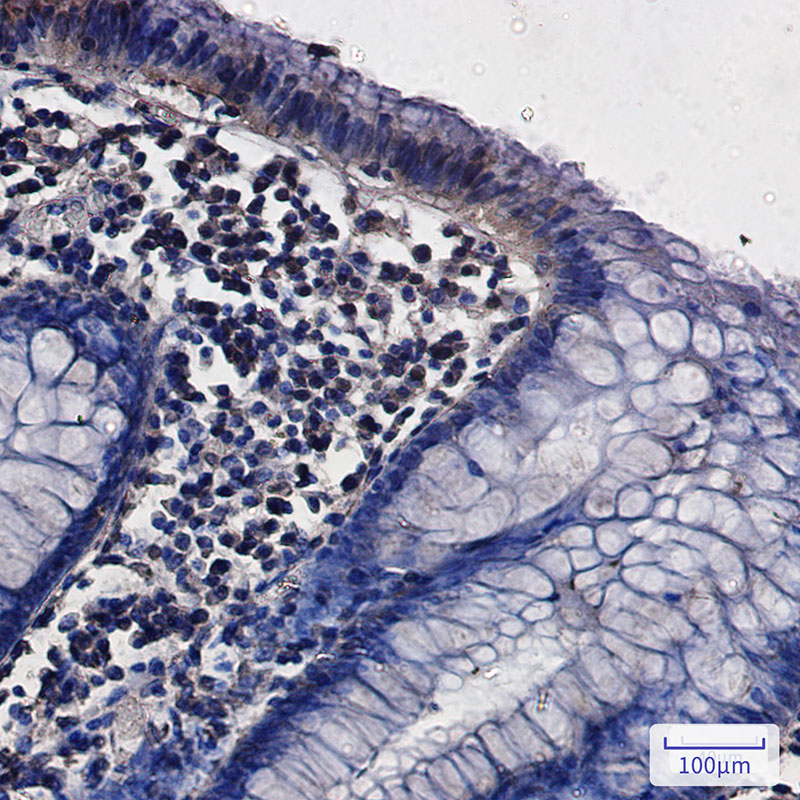


| WB | 咨询技术 | Human,Mouse,Rat |
| IF | 1/20 | Human,Mouse,Rat |
| IHC | 1/50-1/100 | Human,Mouse,Rat |
| ICC | 1/50-1/200 | Human,Mouse,Rat |
| FCM | 咨询技术 | Human,Mouse,Rat |
| Elisa | 咨询技术 | Human,Mouse,Rat |
| Aliases | G3BP1; G3BP; Ras GTPase-activating protein-binding protein 1; G3BP-1; ATP-dependent DNA helicase VIII; hDH VIII; GAP SH3 domain-binding protein 1 |
| Entrez GeneID | 10146 |
| WB Predicted band size | Calculated MW: 52 kDa; Observed MW: 68 kDa |
| Host/Isotype | Rabbit IgG |
| Antibody Type | Primary antibody |
| Storage | Store at 4°C short term. Aliquot and store at -20°C long term. Avoid freeze/thaw cycles. |
| Species Reactivity | Human,Mouse,Rat |
| Immunogen | A synthetic peptide of human G3BP |
| Formulation | Purified antibody in TBS with 0.05% sodium azide,0.05%BSA and 50% glycerol. |
+ +
以下是关于G3BP抗体的3篇参考文献及其摘要概括:
1. **文献名称**:*"The RasGAP-associated endoribonuclease G3BP assembles stress granules"*
**作者**:Tourrière, H., et al.
**摘要**:该研究揭示了G3BP1通过招募RNA和蛋白组分促进应激颗粒(stress granules)的形成,在细胞应激反应中起关键作用。实验中使用G3BP抗体验证其在颗粒中的定位与功能。
2. **文献名称**:*"G3BP1 promotes stress-induced autophagy by the USP10–p53 pathway in cancer cells"*
**作者**:Somasekharan, S.P., et al.
**摘要**:研究发现G3BP1通过调控USP10-p53通路激活自噬,影响肿瘤细胞存活。研究通过G3BP抗体抑制实验证实其在癌症治疗中的潜在靶点价值。
3. **文献名称**:*"TDP-43 and G3BP1 regulate stress granule dynamics in ALS/FTD"*
**作者**:Dodson, C.A., et al.
**摘要**:该文献探讨了G3BP1与TDP-43在肌萎缩侧索硬化症(ALS)中的相互作用,利用G3BP抗体发现应激颗粒异常聚集与神经退行性病变的相关性。
---
以上文献均涉及G3BP抗体的应用,涵盖基础机制、癌症及神经疾病研究领域。如需具体文章,建议通过PubMed或期刊数据库按标题检索。
G3BP (Ras GTPase-activating protein-binding protein) antibodies are essential tools for studying the multifaceted roles of G3BP proteins in cellular stress responses and RNA metabolism. G3BP1 and G3BP2. the two homologous isoforms, are RNA-binding proteins that nucleate stress granules (SGs)—dynamic cytoplasmic aggregates formed during stress to transiently halt non-essential translation. Structurally, G3BP proteins contain an N-terminal nuclear transfer factor 2 (NTF2) domain for dimerization, an RNA-binding domain (RRM), and an arginine-glycine-rich (RGG) motif for RNA interactions.
G3BP1. the better-characterized isoform, regulates SG assembly by binding and condensing untranslated mRNAs under stress (e.g., oxidative stress, heat shock, or viral infection). It also participates in diverse pathways, including mRNA stability, miRNA processing, and antiviral signaling. Dysregulation of G3BP1 is linked to neurodegenerative diseases (e.g., ALS) and cancers, where it may promote tumor progression via stress adaptation.
G3BP antibodies are widely used to detect protein expression, localization, and SG dynamics in immunoblotting, immunofluorescence, or immunoprecipitation. Specific antibodies targeting distinct epitopes (e.g., phosphorylated residues) help dissect post-translational modifications regulating G3BP activity. Commercial antibodies are often validated for cross-reactivity between human, mouse, and rat homologs. As G3BP1 emerges as a therapeutic target (e.g., in viral replication inhibition or cancer), these antibodies remain critical for mechanistic studies and drug development.
×